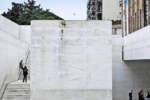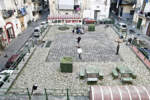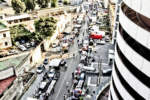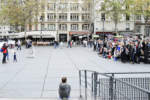Sometimes it only takes a little, even just an idea, a sudden curiosity, to begin a research project. It happened in 2009 with a contribution on the pages of this very magazine in which I have begun to reflect, on the basis of an analysis of the architectural languages characterizing shopping venues, on the subject of non-places through the relationship between space, function, form and language. From the initial analysis, the research has continued towards the definition of a completely new model of “place” that can represent an alternative to the “non-places” characterizing contemporary relational manners, whether real or virtual, with which to decline today’s multifunctional and atopic community spaces, which lack an own specific identity except that of adapting to and pursuing a coexistence of ideas and behaviours, a rapid pace, ephemerality and temporality, on the basis of a predominant theme or function.
The material produced by the research team which I have coordinated has then been collected in a book which links the architectural phenomenon to speculations on anthropology, economy, linguistic philosophy and the most advanced frontiers of applied information technology and virtual reality understood as nodes of relations and communication systems rather than mere representation.
The balance of what has happened, in this short period of time, which is moreover clearly temporary as it is characterized by a process of evolution, fails to meet the expectations – that are certainly high – even if it significant progress has been made. But while the research elaborates more and more, and increasingly stimulating, reflections on the themes of applicative models – something which is also demonstrated by the theme of this issue of Area – the diffused design practice, which designs the environment in which we live, too often still remains at the service of the “market” and its demands, thus expecting products that are reassuring in terms of results and evolution.
As corroboration of the projections of critics and scientific studies we may, however, observe a timid change in trend: works and realizations which give the precise sensation that it possible to appropriate the researches and apply them to projects, listen to the users, who are clearly manifesting an urgent demand for services and values that are capable of adapting collective places, giving a built form to the expectations of their everyday existence. Shopping malls and outlets that no longer flaunt styles from the past, on the contrary – without feverishly seeking unlikely contemporary designs – promoting relations and interactions between spaces and users, between territory and architectural construction, between accessibility and means of transport; waiting or transit areas which define areas for resting or waiting that are adapted to the psychology of travellers, overcoming obsolete and alienating functional and distributive schemes; new infrastructural models that seek to mediate the transition between the landscape and its modification, between the urban space and the expectations of privacy, of domestic life.
These are examples of a process that is taking place, and which has clearly not only understood – even if late – the criticism that has been levied on the loss of the real sense of “community”, but also appreciated the need to facilitate new forms of social relations and communication in order to succeed in uniting marketing strategies and satisfaction of needs, promotion of products and, at the same time, of ideas and cultural growth.
This is taking place on the basis of new forms of language and expression, that are sometimes considered marginal or trendy, but that are on the contrary characterizing our lives: channels of communication, interaction and promotion of ideas and products which have evolved in the last few years and that belong to the so-called immaterial world, to the virtual logics of information technology that have definitively transformed our relational and even physical behaviour, habits and our hierarchies of values.
The spaces of connection, junction and relation that we are surrounded by absorb these relational changes and, in the best cases, adapt themselves to express senses that are not definitive but in evolution, concretizing not so much the functions but the reasons that substantiate them, adapting language and morphology, composition and distribution to the physical and psychological needs of those who use them. No longer spaces for “users”, but places in which one may play an active role, contribute to create environments to “use”, to transform, that make it possible to express oneself with creativity: true relational environments which one may design with one’s presence, by using and frequenting them, thus defining them and adapting them to one’s own requirements, moods and character. The purpose is to design flexible and changeable spaces, in which to experiment sensations and emotions, in which it is not necessary to undergo induced stimuli or conform to codified behaviours, which may favour encounters and the assertion of own, individual choices rather than amplifying one’s own solitude through the repetition of false rituals, where one may communicate and learn, study and put one’s past experiences into play. In the final analysis, real, physical and tangible spaces in which to succeed in reconstructing the dynamism, flexibility and creativity intrinsic in the “virtual places” that are today defining and conditioning the new systems of social relations and communication.
These places without any concrete substance, initially created by habits and a way to understand the world, moulded by experience and by sensorial knowledge, have then evolved and been consolidated in a mental rather than physical dimension, in open and free relationships rather than social hierarchies. Intangible “piazzas” adapted to one’s own habits, built on the basis of the natural limits of spaces for meeting, shopping, information, business, culture and creativity that are available to humans. Cyber-places, as they have often been defined, which have today become something more than an emanation of reality, turning back on it to influence and modify it. It is therefore the material reality that can no longer do without the interaction learnt in the virtual dimension, an exchange between different things, different people, and between things and people, to which we are by now accustomed.
In fact, interactivity implies a possibility to choose, to autonomously build the system of actions and information one needs, adapting objects or spaces to one’s preferences. The user, no longer content with being a passive spectator, demands to play an active role, making his own decisions with regard to the character of the environment in which he wants to live. A real interactivity, that is no longer a mere slogan, can result in places that differ depending on who is using them, from day to day, in short spaces that are “designed” by the individual visitor, as he or she may see fit.
It is evident that the present-day society, whether it is postmodern or, as recent studies indicate, something beyond postmodernism, needs spaces in which any condition may be experienced in a satisfactory manner, whether it is a matter of voluntary anonymity or active participation, and in which one may choose if and when to interact, to express oneself or to communicate with others. In the final analysis, non-places, with their deformation of reality and banalization of the relational systems, have involuntarily adapted to and concretized the changing expectations of society to a much greater degree than the more noble “places” produced by an architecture that has, for years, become increasingly distant from desires that may be elementary, but that are shared by the single individuals. On the contrary, the contemporary information and multimedia technologies have not cancelled interpersonal relations, only changed them: as compared to the real piazza, the virtual one is no longer just a place which accommodates individualities, it is also a showcase in which to present oneself to others and, through precise communication channels, filter relationships. In this sense, individually is not understood as solitude, because it does not exclude contact with the rest of the world5; one may give and take, grant and receive, choose to show only what one wants to share with the rest of the community that uses the same places, whether real or virtual. The potential interactions between humans and spaces, between the physical conformation of the latter and personal preferences, may therefore be determined by own virtual conducts, something which suggests the direct participation of the single individual, who takes care that that part of one’s private existence which one wants to share with the public is controlled and regulated directly by the user, and not filtered by imposed strategies.The architect can no longer entrench himself within the limits of his profession and thus lose sight of the potentials, not excluding the risks, of the relational modalities inferred from the immaterial world of the web and the instruments with which he participates in it. The purpose is to cancel borders between experiences held to be distinct, make collective places personal and interactive, expand the feeling of belongingness and privacy, to allow architectural spaces, which already as such elicit a complex and complete sensorial, cognitive and perceptive involvement, to adapt themselves to dreams and hopes in real time, translating technologies into events that are useful for the signifying and declination of the inhabitable space in every form.
By adapting to this process we will avoid to create new non-places, and build places for interaction and exchange, spaces that refer to other, flexible and adaptable rather than definitive and absolute ones, in which to accomplish every desired or demanded action. Environments charged with personality, no longer aseptic concentrates of functions in which needs are merely met, but significant places in which to spend one’s time in a creative and free manner. It is the responsibility of those who design and research in this field to shift the focus of their attention from the typology and morphology of the place to its flexibility and adaptability, from a direct communication between place and user to a possibility to form completely new relations and connections with the space around one, and at the same time with other analogous spaces endowed with the same potential, from a declination and circumscription of clearly defined functions to an opening towards requirements and needs, that enable one to understand reality and make others know about one’s existence, in which one may cultivate the utopia of an environment suited to everyone, and capable of reflecting the contemporary reality.
Paolo Giardiello, architect, has been associated professor in furniture and interior architecture since 2002. From 1995 to 2006 he has been invited every year to teach advanced and specialization courses at academic and research institutions in Central and South America; he is at present manager of international relations between academic institutions with Uruguay and Mexico and collaborates with research projects conducted in Argentina and Cuba.
From 2008 to 2012 he has been chairman of the council for cultural activities of the architecture faculty of Naples, and as of 2013 he is a member of the junta of the department and the commission for cultural activities of the DiARC Department of Architecture. His current research projects centre on specific disciplinary issues linked to living and the domestic space, the use of public and collective places and the languages of contemporaneity in architecture.
Giovanni Fabbrocino architect, photographer. It is a lover of Matter in Interior Architecture and Exhibition Design at the Department of Architecture (DiARC) of the University of Naples “Federico II“, where he works in educational activities and research projects with Paolo Giardiello. Freelancer, has participated in numerous photo exhibitions, won competitions and published in magazines and photo books.









